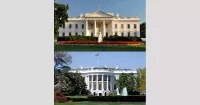Myanmar, also known as Burma, is a Southeast Asian country bordered by India, Bangladesh, China, Laos, and Thailand. With a population of approximately 55 million, it is the largest country in Mainland Southeast Asia. Naypyidaw is the capital city, while Yangon is the largest city. Myanmar is located between the Andaman Sea and the Bay of Bengal.
1914: Jehovah's Witnesses Presence
Jehovah's Witnesses have been present in Myanmar since 1914 and have about 80 congregations around the country and a branch office in Yangon publishing in 16 languages.
1920: First Burmese silent film
In 1920, the first Burmese silent film, "Myitta Ne Thuya (Love and Liquor)", was released and proved to be a major success despite its poor quality.
April 1937: Burma becomes a separately administered colony
On 1 April 1937, Burma became a separately administered colony of Britain, and Ba Maw became the first Prime Minister and Premier of Burma.
August 1942: Burmese Executive Administration established
In August 1942, a Burmese Executive Administration headed by Ba Maw was established by the Japanese.
1942: Burma National Army fights with Japanese
From 1942, the Burma National Army and the Arakan National Army fought with the Japanese.
1943: Arrival of Merrill's Marauders
In 1943, Merrill's Marauders, an American unit, followed the British Chindits into the Burmese jungle.
1944: Allied troops launch offensives
Beginning in late 1944, allied troops launched a series of offensives that led to the end of Japanese rule.
July 1945: End of Japanese rule
In July 1945, Japanese rule in Burma ended after a series of offensives by allied troops.
July 1947: Assassination of Aung San
In July 1947, political rivals assassinated Aung San and several cabinet members.
1947: Burma Independence Act
In 1947, the Burma Independence Act was enacted, setting the stage for Myanmar's declaration of independence on 4 January 1948.
January 1948: Myanmar declares independence
On 4 January 1948, Myanmar declared its independence under the terms of the Burma Independence Act 1947.
January 1948: Independence as the Union of Burma
On 4 January 1948, the nation became an independent republic named the Union of Burma under the Burma Independence Act 1947, with Sao Shwe Thaik as its first president and U Nu as its first prime minister.
1948: Parliamentary Government Formed
In 1948, after a parliamentary government was formed in Burma, Prime Minister U Nu embarked upon a policy of nationalisation and the state was declared the owner of all of the land in Burma.
1951: Multi-party elections
Multi-party elections were held in 1951-1952.
1952: Multi-party elections
Multi-party elections were held in 1951-1952.
1956: Multi-party elections
Multi-party elections were held in 1956.
1957: Myanmar Joins IAEA
Myanmar has been a member of the International Atomic Energy Agency (IAEA) since 1957.
1958: Anglo-Burmese Emigration
From 1958 onwards, the Anglo-Burmese population left the country in steady streams, principally to Australia and the United Kingdom.
1960: Multi-party elections
Multi-party elections were held in 1960.
1961: Myanmar hosted the Southeast Asian Games
In 1961, Myanmar hosted the Southeast Asian Games.
1961: U Thant elected Secretary-General of the United Nations
In 1961, U Thant was elected Secretary-General of the United Nations, a position he held for ten years.
March 1962: Military coup led by General Ne Win
On 2 March 1962, the military, led by General Ne Win, took control of Burma through a coup d'état.
July 1962: Government breaks up demonstrations at Rangoon University
On 7 July 1962, the government broke up demonstrations at Rangoon University, killing 15 students.
1962: Military coup d'état
In 1962, a coup d'état resulted in a military dictatorship under the Burma Socialist Programme Party.
1962: Coup d'état Followed by Burmese Way to Socialism
The 1962 coup d'état was followed by an economic scheme called the Burmese Way to Socialism, a plan to nationalise all industries, with the exception of agriculture.
1962: Military Coup and Persecution of Ethnic Groups
The persecution of Burmese Indians, Burmese Chinese and other ethnic groups after the military coup headed by General Ne Win in 1962 led to the expulsion or emigration of 300,000 people.
1962: Beginning of the Military Regime
There is consensus that the former military regime in Myanmar (1962–2010) was one of the world's most repressive and abusive regimes.
1964: Nationalisation of Private Enterprise
In 1964, the wholesale nationalisation of private enterprise led to further emigration as people sought to escape racial discrimination.
1966: Modern Rice Varieties Released
Through collaboration with the International Rice Research Institute, 52 modern rice varieties were released in the country starting in 1966.
1969: Myanmar hosted the Southeast Asian Games
In 1969, Myanmar hosted the Southeast Asian Games.
1974: Rule by revolutionary council
Between 1962 and 1974, Myanmar was ruled by a revolutionary council headed by General Ne Win.
1974: New constitution adopted
In 1974, a new constitution of the Socialist Republic of the Union of Burma was adopted.
1975: Student protests suppressed
In 1975, student protests were quickly suppressed by overwhelming force.
1976: Student protests suppressed
In 1976, student protests were quickly suppressed by overwhelming force.
1977: Student protests suppressed
In 1977, student protests were quickly suppressed by overwhelming force.
1978: King Dragon Operation
As a result of the King Dragon operation in Arakan, 200,000 Rohingya refugees headed to neighbouring Bangladesh in 1978.
1982: Denial of Citizenship to Rohingya People
Since 1982, the Rohingya people have faced severe persecution, being denied citizenship and basic rights.
1983: Fertility Rate
The fertility rate was 4.7 children per woman in 1983.
1987: Rice Production Increased to 14 Million Tons in 1987
By 1987, national rice production increased to 14 million tons.
1987: Myanmar Asked for Least Developed Country Status in 1987
In 1987, Myanmar asked for admittance to a least developed country status to receive debt relief.
August 1988: 8888 Uprising
On 8 August 1988, the 8888 Uprising led to a nominal transition to a multi-party system two years later, but the military refused to cede power.
1988: Modern Rice Varieties Planted on Half of Ricelands
By 1988, modern rice varieties were planted on half of the country's ricelands, including 98 percent of the irrigated areas.
1988: Increased government control of the film industry
Following the political events of 1988, the government increasingly controlled Myanmar's film industry, banning film stars involved in political activities and issuing strict censorship rules.
1988: 8888 Uprising
In 1988, unrest over economic mismanagement and political oppression led to widespread pro-democracy demonstrations known as the 8888 Uprising.
1988: One-party system rule ends
Until 1988, Myanmar was ruled as a one-party system, with the general and other military officers ruling through the Burma Socialist Programme Party (BSPP).
May 1989: Military government finalizes plans for People's Assembly elections
In May 1989, the military government finalized plans for People's Assembly elections on 31 May 1989.
June 1989: Name change to "Union of Myanmar"
On 18 June 1989, the SLORC changed the country's official English name from the "Socialist Republic of the Union of Burma" to the "Union of Myanmar".
1989: Official name change to Myanmar
In 1989, the military government officially changed the English names of places, including the country's name from Burma to Myanmar.
May 1990: Free multiparty elections
In May 1990, the government held free multiparty elections, and the National League for Democracy (NLD) won.
1990: Maternal Mortality Rate
The 1990 maternal mortality rate per 100,000 births for Myanmar is 662.
1992: General Than Shwe takes over chairmanship
In 1992, General Than Shwe took over the Chairmanship from General Saw Maung.
1992: Myanmar Signs Nuclear Non-Proliferation Pact
Myanmar is one of the signatories of the nuclear non-proliferation pact since 1992.
1996: Rice Production Increased to 19 Million Tons in 1996
By 1996, national rice production increased to 19 million tons.
June 1997: Myanmar admitted into ASEAN
On 23 June 1997, Myanmar was admitted into the Association of Southeast Asian Nations.
1997: State Peace and Development Council
From 1997, the military junta continued to rule the nation as the State Peace and Development Council (SPDC).
1997: 52 Modern Rice Varieties Released by 1997
Through collaboration with the International Rice Research Institute, 52 modern rice varieties were released in the country between 1966 and 1997, helping increase national rice production to 14 million tons in 1987 and to 19 million tons in 1996.
September 2000: Myanmar Informs IAEA of Reactor Construction
In September 2000, the military junta informed the IAEA of its intention to construct a research nuclear reactor.
2000: Literacy rate of 90%
In 2000, Myanmar's official literacy rate was 90% according to the UNESCO Institute of Statistics.
2001: Restrictions on Tourist Interactions
In 2001, the Myanmar Tourism Promotion Board issued an order for local officials to protect tourists and limit "unnecessary contact" between foreigners and ordinary Burmese people.
2001: Fertility Rate
The fertility rate declined to 2.4 children per woman in 2001.
November 2005: Capital moved to Pyinmana
In November 2005, the military junta moved the national capital from Yangon to a site near Pyinmana.
2005: Evidence of Ethnic Minority Extermination Published
In 2005, evidence gathered by a British researcher was published regarding the extermination or "Burmisation" of certain ethnic minorities, such as the Karen, Karenni and Shan.
2005: HIV Prevalence Rate in 2005
In 2005, the estimated adult HIV prevalence rate in Myanmar was 1.3% (200,000–570,000 people), according to UNAIDS. The National AIDS Programme Myanmar found that 32% of sex workers and 43% of intravenous drug users in Myanmar have HIV.
2005: UN General Assembly Adopts Resolution on Myanmar
Until 2005, the United Nations General Assembly annually adopted a detailed resolution about the situation in Myanmar by consensus.
March 2006: New capital named Naypyidaw
On 27 March 2006, the new capital was officially named Naypyidaw.
2006: Divided UN General Assembly Resolution
In 2006, a divided United Nations General Assembly voted through a resolution that strongly called upon the government of Myanmar to end its systematic violations of human rights.
2006: Burmese Refugees Resettled in the United States
Since 2006, over 55,000 Burmese refugees have been resettled in the United States.
2006: Myanmar Gives Up ASEAN Chair
Though Myanmar gave up its turn to hold the ASEAN chair and host the ASEAN Summit in 2006.
August 2007: Saffron Revolution begins
In August 2007, an increase in the price of fuel led to the Saffron Revolution led by Buddhist monks.
September 2007: Government cracks down on Saffron Revolution
On 26 September 2007, the government cracked down on the Saffron Revolution, with reports of barricades and monks killed.
2007: AIDS Deaths in Myanmar
According to Doctors without Borders, 25,000 Burmese AIDS patients died in 2007, deaths that could largely have been prevented by antiretroviral therapy drugs and proper treatment.
2007: Muslims Flee to Bangladesh
By 2007, More than 200,000 Muslims had fled to Bangladesh to escape persecution.
2007: Chroniques Birmanes graphic novel about Myanmar
In 2007, the graphic novel Chroniques Birmanes about Myanmar by Québécois author and animator Guy Delisle was released.
May 2008: Cyclone Nargis
In May 2008, Cyclone Nargis devastated the Irrawaddy Division, causing an estimated 200,000 deaths or missing persons, $10 billion in damages, and leaving around 1 million people homeless. The government was criticized for hindering United Nations recovery efforts, delaying the entry of United States military planes carrying medicine, food, and other supplies.
May 2008: Approval of army-drafted constitution
In May 2008, Myanmar's army-drafted constitution was approved in a referendum. Many international observers and the National League of Democracy considered the results, which showed 92.4% approval from 22 million voters with a 99% turnout, as suspect due to reported widespread fraud, ballot stuffing, and voter intimidation.
September 2008: Drafting of the Constitution
In September 2008, Myanmar's military rulers drafted and published the country's constitution, its third since independence.
November 2008: Tensions with Bangladesh Over Natural Gas
In November 2008, Myanmar's political situation with neighbouring Bangladesh became tense as they began searching for natural gas in a disputed block of the Bay of Bengal.
2008: Zarganar sentenced to prison
In 2008, blogger Zarganar was sentenced to prison for publishing a video of destruction caused by Cyclone Nargis.
2008: Rice Production Estimated at 50 Million Tons in 2008
In 2008, rice production in Myanmar was estimated at 50 million tons.
2008: New draft national constitution published
In 2008, the government published a new draft national constitution and held a national referendum to adopt it. The constitution allowed for the election of a national assembly with powers to appoint a president but ensured army control at all levels.
2008: Burma Chronicles published
In 2008, the graphic novel Chroniques Birmanes by Québécois author and animator, Guy Delisle, was translated into English under the title Burma Chronicles.
2008: Maternal Mortality Rate
The 2008 maternal mortality rate per 100,000 births for Myanmar is 219.3.
November 2009: UN General Assembly Condemns Human Rights Violations
In November 2009, the General Assembly adopted a resolution "strongly condemning the ongoing systematic violations of human rights and fundamental freedoms".
2009: Burmese Refugees Living in Refugee Camps
As of 2009, 110,000 Burmese refugees were living in refugee camps in Thailand.
2009: Burma VJ documentary released
In 2009, a documentary about Burmese videojournalists called Burma VJ was released.
2010: Pew Research Center Estimates
According to the 2010 estimates of the Pew Research Center, 7% of the population is Christian; 4% is Muslim; 1% follows traditional animistic beliefs; and 2% follow other religions, including Mahayana Buddhism, Hinduism, and East Asian religions.
2010: Reforms Following Elections
Following the 2010 elections, Myanmar's foreign relations, particularly with Western nations, have markedly improved.
2010: General election held
In 2010, a general election was held, leading to the official dissolution of the military junta in 2011 and the installation of a nominally civilian government.
2010: Suspicions of North Korean Missile Facility Construction
In 2010, as part of the leaked diplomatic cables, Myanmar was suspected of using North Korean construction teams to build a fortified surface-to-air missile facility.
2010: Elections Result in Victory for Military-Backed Party
In 2010, the elections in Myanmar resulted in a victory for the military-backed Union Solidarity and Development Party, although foreign observers questioned their fairness. One major criticism was that only government-sanctioned political parties could participate, and the popular National League for Democracy was declared illegal. However, following the 2010 elections, Aung San Suu Kyi's house arrest was ended.
2010: Burma VJ nominated for Academy Award
In 2010, the film Burma VJ was nominated for Best Documentary Feature at the Academy Awards.
2010: Maternal Mortality Rate in 2010
The 2010 maternal mortality rate per 100,000 births for Myanmar is 240.
2010: End of the Military Regime
There is consensus that the former military regime in Myanmar (1962–2010) was one of the world's most repressive and abusive regimes.
March 2011: Dissolution of the State Peace and Development Council
In March 2011, the State Peace and Development Council (SPDC) was dissolved.
August 2011: Transition to a New Government
According to the Crisis Group, since Myanmar transitioned to a new government in August 2011, the country's human rights record has been improving.
September 2011: Unblocking of Banned Websites
In September 2011, several banned websites, including YouTube, Democratic Voice of Burma and Voice of America, were unblocked in Myanmar.
September 2011: Foreign Minister Confirms Intention to Release Prisoners
In an address to the United Nations Security Council on 22 September 2011, Myanmar's Foreign Minister Wunna Maung Lwin confirmed the government's intention to release prisoners in the near future.
September 2011: The Lady world premiere
On September 12, 2011, The Lady had its world premiere at the 36th Toronto International Film Festival.
October 2011: Zarganar released from prison
In October 2011, blogger Zarganar, who was sentenced to prison for publishing a video of destruction caused by Cyclone Nargis in 2008, was released.
November 2011: United States Relaxes Curbs on Foreign Aid
In November 2011, the United States relaxed curbs on foreign aid to Myanmar after years of diplomatic isolation and economic and military sanctions.
2011: Military junta dissolved
In 2011, the military junta was officially dissolved following a 2010 general election, and a nominally civilian government was installed.
2011: Myanmar's fertility rate in 2011
Myanmar's fertility rate in 2011 was 2.23, slightly above the replacement level and low compared to Southeast Asian countries of similar economic standing.
2011: Freedom House Report on Human Rights in Myanmar
The Freedom in the World 2011 report by Freedom House notes, "The military junta has ... suppressed nearly all basic rights; and committed human rights abuses with impunity."
January 2012: Resumption of Diplomatic Relations with the United States
On 13 January 2012, the United States announced the resumption of diplomatic relations with Myanmar.
May 2012: United States Eased Sanctions on Myanmar
From May 2012, the United States began to lift its economic sanctions on Myanmar "in response to the historic reforms that have been taking place in that country."
August 2012: Government announced end to media censorship
On August 20, 2012, the Burmese government announced that it would stop censoring media before publication.
November 2012: White House Report on Human Rights Abuses
In November 2012, Samantha Power, Barack Obama's Special Assistant to the President on Human Rights, wrote on the White House blog that "Serious human rights abuses against civilians in several regions continue, including against women and children."
2012: High murder rate and corruption
In 2012, Myanmar had a murder rate of 15.2 per 100,000 population, totaling 8,044 murders. The country was also ranked 171 out of 176 countries in the Transparency International Corruption Perceptions Index.
2012: Government removed media censorship
In 2012, the government of Myanmar removed media censorship, which had previously involved authorities monitoring e-mails and Internet blogs.
2012: Freedom in the World Report Notes Improvement
The 2012 Freedom in the World report notes improvement in Myanmar, giving it a 6 for improvements in civil liberties and political rights.
February 2013: United States Lifted Economic Sanctions on Myanmar
The United States continued to lift its economic sanctions on Myanmar through February 2013.
April 2013: Publication of privately owned newspapers commenced
In April 2013, international media reported the enactment of media liberalisation reforms announced in August 2012, and the publication of privately owned newspapers commenced for the first time in numerous decades.
May 2013: Myanmar President Visits the White House
In May 2013, Thein Sein became the first Myanmar president to visit the White House in 47 years. On 21 May 2013, the two governments agreed to sign a bilateral trade and investment framework agreement.
June 2013: Myanmar Hosts World Economic Forum on East Asia
In June 2013, Myanmar held its first ever summit, the World Economic Forum on East Asia 2013. The summit was held on 5–7 June and attended by 1,200 participants.
July 2013: Political Prisoners in Burmese Prisons
In July 2013, the Assistance Association for Political Prisoners indicated that there were approximately 100 political prisoners being held in Burmese prisons.
2013: Declaration to Release All Political Prisoners
Following Thein Sein's first ever visit to the UK in 2013, the Myanmar president declared that all of his nation's political prisoners will be released by the end of the year.
2013: Continued Improvement in Human Rights Ratings
In 2013, Myanmar improved yet again, receiving a score of 5 in civil liberties and 6 in political freedoms.
2013: GDP statistics
In 2013, Myanmar's GDP (nominal) stood at US$56.7 billion and its GDP (PPP) at US$221.5 billion.
2013: Southeast Asian Games took place in Myanmar
In December 2013, the Southeast Asian Games took place in Naypyidaw, Yangon, Mandalay and Ngwesaung Beach, Myanmar. This marked the third time the event had been held in Myanmar.
2013: Commercial Overland Tourist Routes Established
Since 2013, at least one tourist company has successfully run commercial overland routes through borders such as the border between Ruili (China) to Mu-se, the border between Htee Kee (Myanmar) and Phu Nam Ron (Thailand), and the border between Myawaddy and Mae Sot, Thailand.
December 2014: Yangon Stock Exchange Set Up
In December 2014, Myanmar set up its first stock exchange, the Yangon Stock Exchange.
2014: Myanmar Census
According to the 2014 Myanmar Census, 87.9% of the population identifies as Buddhists; 6.2% of the population identifies as Christian; 4.3% as Muslim; 0.8% as followers of tribal religions; 0.5% as Hindus; 0.2% as followers of other religions; and 0.1% follow no religion.
2014: Myanmar Census Shows Population of 51,419,420
The provisional results of the 2014 Myanmar Census showed that the total population was 51,419,420. This figure includes an estimated 1,206,353 persons in parts of northern Rakhine State, Kachin State and Kayin State who were not counted.
2015: Myanmar general election held
In 2015, the Myanmar general election was held, leading to improved foreign relations and eased economic sanctions.
2015: Opium poppy cultivation declined year-on-year since 2015
Since 2015, opium poppy cultivation in Myanmar had declined year-on-year.
2016: Accusations Against Aung San Suu Kyi
In 2016, Myanmar leader Aung San Suu Kyi was accused of failing to protect Myanmar's Muslim minority.
2016: Low ranking in Networked Readiness Index
In 2016, Myanmar was ranked number 133 overall in the World Economic Forum's Networked Readiness Index (NRI), which included 139 countries.
August 2017: Doctors Without Borders Reports Sexual Assaults on Rohingya
Since August 2017, Doctors Without Borders have treated 113 Rohingya refugee females for sexual assault.
August 2017: Rohingya Genocide
Since August 2017, an estimated 23,000–43,700 Rohingya have been killed in the ongoing Rohingya genocide, and another 730,000 have fled to Bangladesh.
2017: Myanmar GDP (Purchasing Power Adjusted)
Myanmar's estimated purchasing power adjusted GDP was US$327.629 billion in 2017 according to the World Bank.
2019: US Assesses Myanmar's Nuclear Obligations
As of 2019, the United States Bureau of Arms Control assessed that Myanmar is not in violation of its obligations under the Non-Proliferation Treaty.
2019: Myanmar GDP
In 2019, Myanmar's nominal GDP was US$76.09 billion.
May 2020: Asia's Largest Ever Drug Operation Reported
In May 2020, Myanmar authorities reported Asia's largest drug operation in Shan State. Authorities seized 193 million methamphetamine tablets, hundreds of kilograms of crystal methamphetamine, heroin, over 162,000 litres and 35.5 tons of drug precursors, sophisticated production equipment, and staging and storage facilities.
2020: Military seizes power in coup d'état
Following the 2020 Myanmar general election, the Burmese military seized power in a coup d'état, leading to widespread protests and violent political repression.
February 2021: Conflict Threatens Rare-Earth Mines
As of February 2021, conflict in Kachin State has threatened the operations of Myanmar's rare-earth mines.
February 2021: Military Deposes Civilian Government
In February 2021, the Tatmadaw deposed the civilian government led by Aung San Suu Kyi. The military declared a one-year state of emergency, with First Vice President Myint Swe becoming Acting President and handing power to Commander-in-Chief Min Aung Hlaing.
2021: Record Methamphetamine Seizures in East and Southeast Asia
In 2021, countries in East and Southeast Asia collectively witnessed sustained increases in seizures of methamphetamine, totaling over 171 tons and a record of over 1 billion methamphetamine tablets according to the United Nations Office on Drugs and Crime.
2021: Displacement due to civil war
Since 2021, more than 600,000 people have been displaced across Myanmar due to the civil war post-coup.
2021: Increase in Illegal Organ Trade Due to Poverty
The military takeover in 2021 worsened poverty in country pushing people to extreme measures like illegal organ trade.
2022: Opium Cultivation Area Increased by 33% in 2022
In 2022, the opium cultivation area in Myanmar increased by 33%, totaling 40,100 hectares, and the yield potential increased by 88% to 790 tonnes, according to the United Nations Office on Drugs and Crime (UNODC) Myanmar Opium Survey 2022.
November 2024: ICC Files Arrest Warrant Application for Min Aung Hlaing
In November 2024, the ICC prosecutor Karim A.A. Khan KC filed an arrest warrant application of Senior General Min Aung Hlaing for crimes against humanity of deportation and persecution of the Rohingya.
December 2024: Refugee and internally displaced persons statistics
As of December 2024, there are over 1.3 million people counted as refugees and asylum seekers, and 3.5 million people displaced internally, according to UNHCR.
2024: Myanmar Ranked Among Most Autocratic Countries
According to the V-Dem Democracy indices, Myanmar in 2024 was one of the most autocratic countries in the world.
2024: Global Innovation Index Ranking
In 2024, Myanmar was ranked 125th in the Global Innovation Index.
January 2025: ASEAN Urges Myanmar Junta to Prioritise Ceasefire
On 19 January 2025, Reuters reported that ASEAN had told Myanmar's military government to prioritise ceasefire, urging the junta to start dialogue and end hostilities immediately and to allow unhindered humanitarian access.
Mentioned in this timeline

The White House located at Pennsylvania Avenue NW in Washington...

Martial law is the imposition of military rule in place...
India officially the Republic of India is a South Asian...
The Association of Southeast Asian Nations ASEAN is a regional...
Africa is the second-largest and second-most populous continent comprising of...
China officially the People's Republic of China PRC is an...
Trending

Adam Thielen is a professional American football wide receiver who most recently played for the Carolina Panthers He is known...

29 days ago Jake Paul to Fight Anthony Joshua on December 19: A Sensational Boxing Match

27 days ago Maxxine Dupri, assisted by AJ Lee, dethrones Becky Lynch for Intercontinental Title on Raw!

6 months ago Stephanie Vaquer Features on WWE SmackDown Amidst Cena & Paul's Ambush.

9 months ago Michael Keaton's Batman: Catchphrase, Killer Moments, and Reboot Rescue Attempts Explored.
5 months ago TJ Watt becomes highest-paid non-QB after extension; JJ Watt reacts hilariously.
Popular

Candace Owens is an American conservative political commentator and author...

Ilhan Omar is an American politician currently serving as the...

XXXTentacion born Jahseh Dwayne Ricardo Onfroy was a controversial yet...

Frederick Christ Trump Sr - was an American real estate...

Charles James Charlie Kirk was a prominent American right-wing political...

Oprah Winfrey an American talk show host television producer actress...
